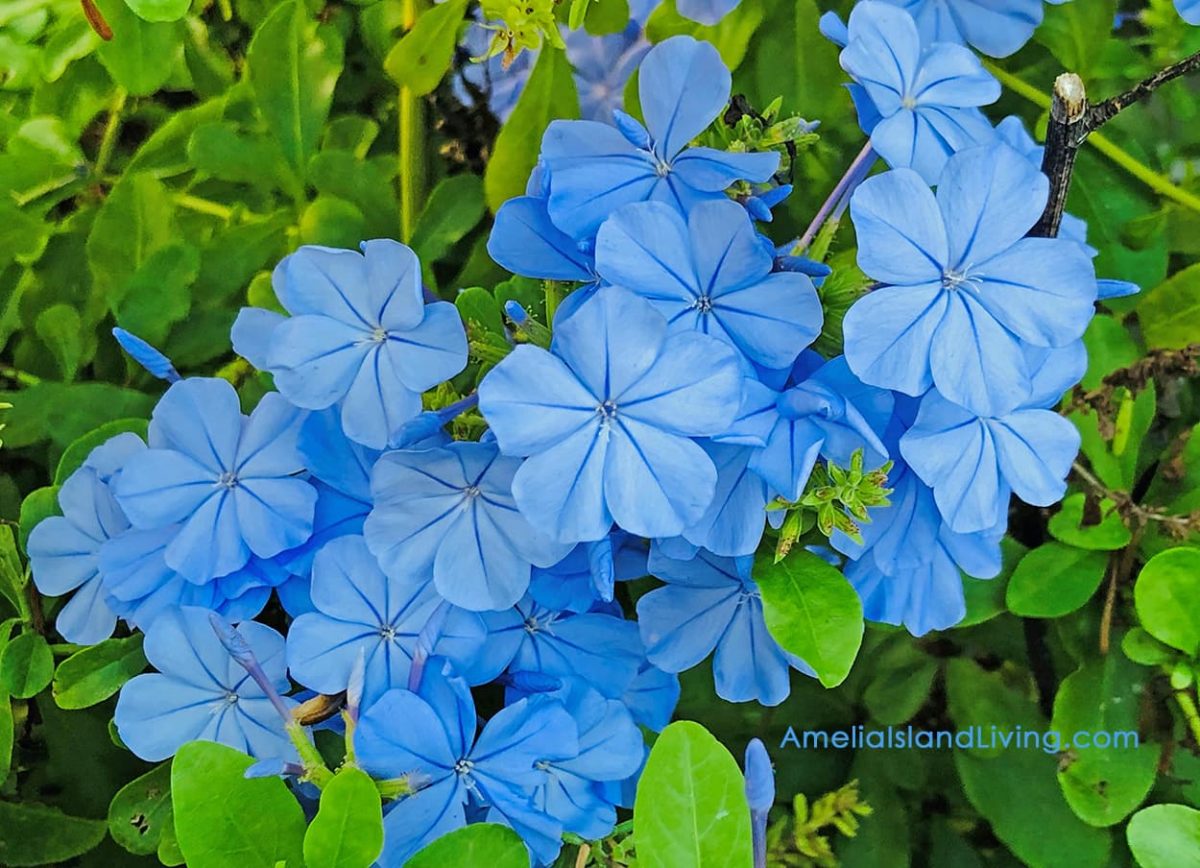EDITOR’S NOTE: Environmental Horticulture Agent III, Rebecca Jordi, addresses questions about landscaping and gardening in northeast Florida. She is the Extension Director in Nassau County, Florida and also a University of Florida faculty member.
QUESTION: I love the blue flowers of the plumbago, but I like planting natives and plants that attract butterflies. I am torn, should I add it to my garden? MM
JORDI: Absolutely, feel free to add this lovely plant to your landscape. While it is not native to Florida, it does behave itself, have very few disease or insect issues, and the butterflies and hummingbirds love it. Quite frankly, I am a fan, too. When I say it behaves, I mean it does not escape and end up in our wildlife areas, overtaking native plants and altering the natural habitats. Diversity is very important, and although we advocate for native plants, we should be equally open to include those trees, shrubs and flowers which would provide additional benefits to our local wildlife. Learn more about plumbago from the University of Florida.
QUESTION: I was walking along Egan’s Creek and saw a plant I thought was Queen Anne’s lace but my friend seems to think it is elderberry. Do you have any ideas? KR

JORDI: It could have easily been elderberry but after looking over the site and sending photographs to the University of Florida, we determined the plant to most likely be a water hemlock. Water hemlock is the most violently toxic plant growing naturally in North America. Only a small amount of the toxic substance in the plant is needed to produce poisoning in livestock or in humans. The toxin cicutoxin, acts directly on the central nervous system causing convulsions.
Cicutoxin has a strong carrot-like aroma. Water hemlock has small, white flowers that grow in umbrella like clusters which looks very similar to the flower of the wild carrot, elderberry and poison hemlock. However, there are some very distinct differences which make the identification easier. Queen Anne’s lace and poison hemlock have very convoluted or lobed compound leaves called tri-pinnate. The leaves of water hemlock and elderberry are more similar to each other but without the deep lobes. Water hemlock stems are herbaceous and smooth (no hair) whereas Elderberry stems are woody (more like a shrub). Queen Anne’s lace has green, hairy stems whereas poison hemlock has smooth, purple spotted stems.
In cases of any type of plant poisoning in humans, contact a Florida poison control center (open 24 hours a day) at 1-800-222-1222 as quickly as possible. All parts of the plant are poisonous but the root is especially potent. The green seed heads have caused death losses in cattle. The leaves and the stems lose their toxicity as they mature. Good reason to not eat something unless you are absolutely certain of the identification.
Since I have said all this scary stuff, I know there will be some concerns about water hemlock growing in a conservation area but there is no reason to become overzealous to remove these plants. If we start removing poisonous plants (azaleas, lantana, coral bean, oleander, etc.), where will it end? All types of poisonous plants have been around for thousands of years and very seldom cause any harm. As a reminder, we should respect all plants and their potential power to both help and harm. However, people who have livestock and a water source should be vigilant to ensure poisonous plants are not growing on their property where animals could ingest them accidentally.
QUESTION: I am moving soon from New York and would like to know which of my beloved perennials I can transplant successfully in my new yard – irises, acuba, daylilies, peonies, and astilbe? GA
JORDI: This is a difficult time to transplant anything here because it is so hot, but with enough water and attention you could transplant the acuba (in shade), daylilies and astilbe (shade). The astilbe is sold in our local nurseries and should be planted in an area where it can receive sufficient moisture – away from drought tolerant plants.
We have plenty of other plants which will do well here, use less water and are better suited for our climate such as Jacobinia. Be sure to look at the Nassau County Florida Extension website for the best information about what grows well in Northeast Florida and check out our demonstration gardens for tried and true plants.
In addition, consider attending our next plant sale (October 5, 2013 9 am -2 pm) for the optimal garden plants for this area.
Sadly, you should leave the irises and peonies in New York. The bearded irises you are accustomed to growing are not the best choice, however, we do have a variety of irises (African irises) available to choose from which are hardy and flower beautifully from spring through fall. Nothing quite matches the beauty of a peony but you might consider replacing it with Rose of Sharon or a Knock-Out rose shrub.

Environmental Horticulture
543350 U. S. Highway #1
Callahan, Florida 32011
E-mail: [email protected]
Phone: 904-491-7340
